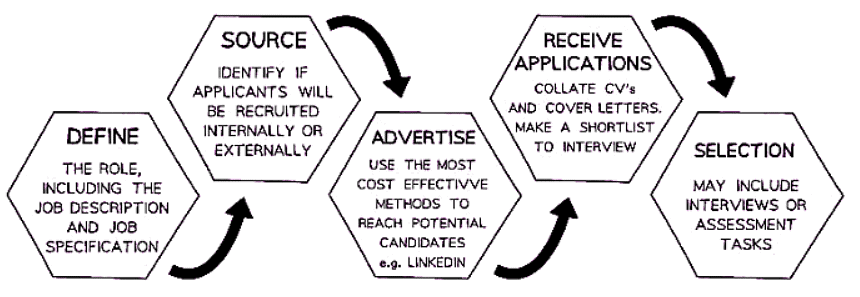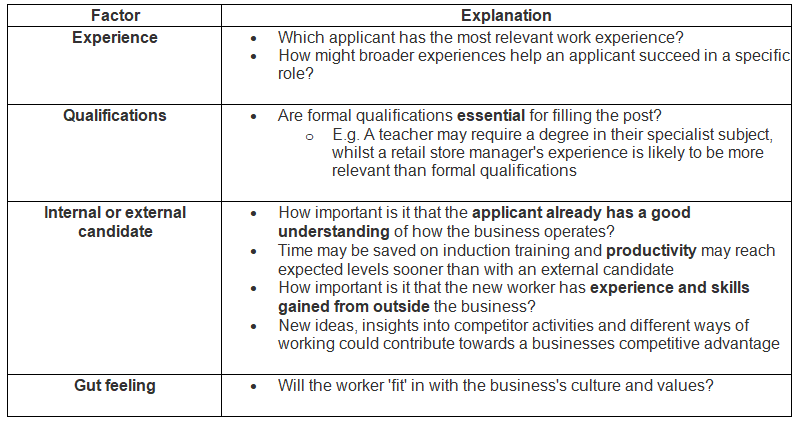Choosing the Right Employee | Business Studies for GCSE/IGCSE - Class 10 PDF Download
The Employee Recruitment Process
- The process of recruitment and selection outlines the various steps a company undertakes to onboard new employees
- Typically, a manager or HR representative is designated to oversee the application process. This individual, sometimes with a team, will create a list of potential candidates from the received applications
- After receiving applications, a manager or an HR staff member is usually chosen to oversee the application process. They, along with others if necessary, will compile a list of potential candidates from the applications received. This list, known as a shortlist, consists of individuals who will be either invited for interviews or requested to complete assessment tasks
Stages in the Recruitment Process

Step 1: Defining the Role
- Organizations should precisely identify the requirements for the role, which includes formulating a job description and a person/job specification.
- A job specification, also referred to as a person specification, details the qualifications, skills, experience, and personal attributes expected from a candidate for a particular job. For instance, qualities like problem-solving skills, effective communication, or proficiency in Java coding may be specified.
- On the other hand, a job description outlines the responsibilities, duties, and prerequisites associated with a specific job.
Comparison of the Person Specification and Job Description
Step 2: Identifying the Source of Required Employees
- Internal recruitment involves promoting or redeploying existing employees within the organization. This method fosters employee growth, boosts morale, and can result in cost and time savings on training.
- External recruitment, on the other hand, entails bringing in new talent from outside the organization. This approach can introduce fresh perspectives, experiences, and ideas to the company.
Step 3: Advertising the Role
When it comes to advertising a position within a company, it is essential to reach out to potential candidates effectively. Here are some key strategies:
- Utilize various platforms to advertise the job opening, such as online job boards, social media, and the company's website.
- Create a compelling job description that clearly outlines the responsibilities, requirements, and benefits of the role to attract suitable candidates.
- Highlight the company culture and values in the job advertisement to ensure alignment with potential candidates.
- Engage with recruitment agencies or headhunters to reach a wider pool of qualified candidates.
- Advertising Job Roles
- Job roles can be advertised either internally or externally by businesses.
- For internal candidates, avenues such as business newsletters, staff noticeboards, or internal emails can be utilized for displaying job advertisements.
- Line managers might recommend suitable candidates post appraisals.
- External candidates can be reached through advertisements in newspapers, industry magazines, specialized recruitment websites, agencies, and government-run agencies.
- Existing employees may nominate individuals they know for roles, sometimes receiving rewards if their nominees are successfully recruited.
- High-level roles can be filled using headhunting strategies.
- Businesses with a robust social media presence can cost-effectively advertise job roles on platforms like Facebook, LinkedIn, and TikTok.
- Specialist recruitment portals can be employed for advertising, although they are costly and target specific applicant groups.
- For example, in the UK, The Times Educational Supplement is a prominent publication used for recruiting teaching staff.
Step 4: Receiving Applications
Once the recruitment strategies have been employed, the next step involves receiving applications from potential candidates who have been attracted through the various methods mentioned above.
- The company can receive applications from candidates through a Curriculum Vitae (CV) along with a cover letter or an application form.
Curriculum Vitae (CV)
- A CV should be well-organized and clear, typically including:
- Name and contact information
- Qualifications and professional experience
- Positions of responsibility
- Interests
- Referees' names and addresses
Covering Letter
- The accompanying cover letter should clarify:
- Reasons for seeking the job
- Why the applicant is suitable for the advertised position
Application Form
- Application forms are often preferred over CVs as they help in:
- Requesting similar information as a CV
- Seeking specific job-related details
- Facilitating easy comparison of candidate applications
- Being increasingly completed online
Comparison of Application Methods

Step 5: Selection
- Once job applicants have applied and the company has chosen potential candidates, various techniques can be utilized to pick the most suitable individual for the position.
- Interviews are a common method used to engage with applicants. These interactions typically involve a face-to-face, phone, or online conversation between a manager and the applicant to assess their appropriateness for the position. It is crucial to prepare a set of pertinent questions for all candidates and ensure that the interview is conducted fairly and consistently. Interview inquiries may revolve around job-related skills and experiences, past achievements and setbacks along with how they were managed, as well as personal interests and experiences.
Understanding the Interview Process
- They typically involve a direct interaction, whether in person, over the phone, or online, between a manager and a candidate to assess their suitability for a specific role.
- It's crucial to prepare a set of pertinent questions that are asked of all candidates, ensuring the interview is conducted fairly and consistently.
- Interview questions often revolve around the candidate's relevant skills, past experiences (both successes and failures, and how they were handled), as well as personal interests and experiences.
Candidates' Test Assessments
- Candidates may be required to take tests to showcase their competencies and suitability for a position.
- Candidates might need to complete assessments either independently or collaboratively to evaluate their teamwork capabilities.
- Various test formats could encompass:
- Skills assessments, like numeracy tests, to gauge candidates' task execution abilities.
- Aptitude evaluations to determine a candidate's potential for skill enhancement or growth.
- Intelligence tests assessing a candidate's capacity to perform at a specific level.
- Personality tests identifying desired attributes, such as effective team collaboration skills.
Recommending Which Applicant to Employ
- The ultimate decision on which applicant to hire hinges on various factors.
- Even after identifying a suitable candidate, the company must deliberate on whether it can confirm their appointment by meeting the applicant's salary and benefits expectations.
- Can the company satisfy the applicant's salary and benefits requirements?
- Can appropriate additional benefits be provided?
- Are there appealing growth opportunities available for the applicant?
Factors used to Select the Best Applicant

Choosing between two different applicants
- A small children's bookshop business has received two applications for its advertised sales assistant role
- The shop owner is looking to select a candidate who is knowledgeable, excels in customer service, communicates effectively (especially with young customers), and is willing to handle administrative tasks like banking.
- Which of the two applicants is more likely to be hired?
Applicant 1: Sarah
- Sarah performed well in the assessment tests but slightly lagged in communication skills.
- She lacks direct experience working with children but shows enthusiasm to learn and adapt.
- Sarah does not possess a first aid qualification at the moment.
- Overall, Sarah shows potential but may need more training to excel in the role.
Applicant 2: Amira
- Amira excelled in the assessment tests, particularly showcasing strong communication skills, almost 20% better than the other applicant.
- She has practical experience working with children for two weeks, which aligns well with the requirements of the position.
- In addition, Amira holds a valuable first aid qualification, a crucial skill when dealing with children.
- Overall, Amira is deemed a better fit for the sales assistant role based on her skills and experience.

Final Assessment
- Considering the skill set and experience of both applicants, Amira emerges as the stronger candidate for the sales assistant role at the children's bookshop.
- Her superior communication abilities, relevant experience with children, and possession of a first aid qualification make her better suited for the position.
- The decision to appoint Amira is supported by her overall alignment with the job requirements and the potential to excel in the role.
|
70 videos|93 docs|26 tests
|
FAQs on Choosing the Right Employee - Business Studies for GCSE/IGCSE - Class 10
| 1. What are the key stages in the employee recruitment process? |  |
| 2. How do recruiters recommend which applicant to employ? |  |
| 3. What is the importance of choosing the right employee for a company? |  |
| 4. How can employers ensure they are selecting the right employee during the recruitment process? |  |
| 5. What are some common challenges faced during the employee recruitment process? |  |




















